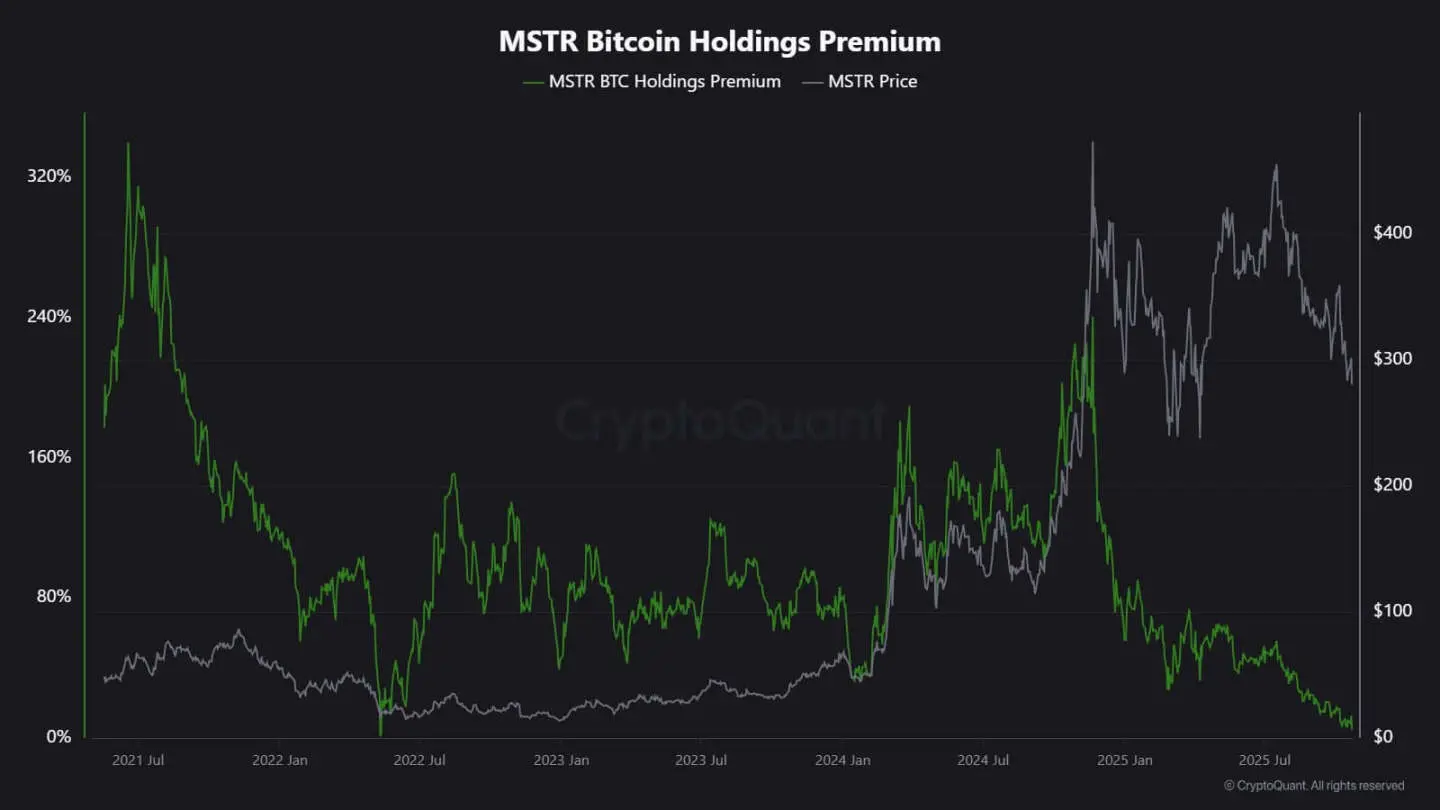Is the fact that Strategy is no longer "aggressively buying" the reason for bitcoin's recent decline?
Spot Bitcoin ETFs, which have long been regarded as "automatic absorbers of new supply," are also showing similar signs of weakness.
Original Author: Oluwapelumi Adejumo, Crypto Slate
Translated by: Luffy, Foresight News
For most of 2025, Bitcoin's support level seemed unshakable because corporate digital asset treasuries (DAT) and exchange-traded funds (ETF) unexpectedly aligned, jointly forming the foundation of support.
Corporations purchased Bitcoin by issuing stocks and convertible bonds, while ETF inflows quietly absorbed new supply. Together, these built a solid demand base, helping Bitcoin withstand the pressures of a tightening financial environment.
Now, this foundation is beginning to loosen.
On November 3, Charles Edwards, founder of Capriole Investments, posted on X that his bullish expectations had weakened as institutional accumulation slowed.
He pointed out: "For the first time in seven months, institutional net buying has fallen below the daily mining supply. This is not good."

Bitcoin institutional buying volume, source: Capriole Investments
Edwards stated that even if other assets outperform Bitcoin, this indicator remains his key reason for optimism.
But as things stand, about 188 corporate treasuries hold significant Bitcoin positions, and many of these companies have relatively simple business models aside from their Bitcoin exposure.
Corporate Bitcoin Treasury Accumulation Slows
No company better represents corporate Bitcoin trading than the recently renamed "Strategy," formerly MicroStrategy.
This software manufacturer, led by Michael Saylor, has transformed into a Bitcoin treasury company and currently holds over 674,000 Bitcoin, firmly establishing itself as the world's largest single corporate holder.
However, its buying pace has slowed significantly in recent months.
Strategy added only about 43,000 Bitcoin in the third quarter, the lowest quarterly purchase this year. Considering that some of its Bitcoin purchases during this period dropped to just a few hundred coins, this figure is not surprising.
CryptoQuant analyst J.A. Maarturn explained that the slowdown may be related to a decline in Strategy's net asset value (NAV).
He said that investors once paid a high "NAV premium" for each $1 of Bitcoin on Strategy's balance sheet, effectively allowing shareholders to share in Bitcoin's upside through leveraged exposure. But since mid-year, this premium has narrowed sharply.
With the valuation premium diminished, issuing new shares to buy Bitcoin no longer brings significant added value, and the incentive for corporate financing and accumulation has also decreased.
Maarturn pointed out: "Financing has become more difficult, and the stock issuance premium has dropped from 208% to 4%."

Strategy stock premium, source: CryptoQuant
Meanwhile, the cooling trend in accumulation is not limited to Strategy.
Tokyo-listed company Metaplanet once emulated this American pioneer, but after a sharp decline in its stock price, it recently traded below the market value of its Bitcoin holdings.
In response, the company approved a stock buyback plan and introduced new financing guidelines to expand its Bitcoin treasury. This move shows the company's confidence in its balance sheet, but also highlights waning investor enthusiasm for the "crypto treasury" business model.
In fact, the slowdown in Bitcoin treasury accumulation has led to some corporate mergers.
Last month, asset management firm Strive announced the acquisition of the smaller Bitcoin treasury company Semler Scientific. After the merger, these companies will hold nearly 11,000 Bitcoin.
These cases reflect structural constraints rather than shaken conviction. When stock or convertible bond issuance can no longer obtain a market premium, capital inflows dry up, and corporate accumulation naturally slows.
What About ETF Fund Flows?
The spot Bitcoin ETFs, long regarded as "automatic absorbers of new supply," have also shown similar signs of weakness.
For most of 2025, these financial investment tools dominated net demand, with subscriptions consistently outpacing redemptions, especially as Bitcoin soared to all-time highs.
But by late October, their fund flows became unstable. Affected by changes in interest rate expectations, portfolio managers adjusted positions, risk departments reduced exposure, and some weekly fund flows turned negative. This volatility marks a new behavioral phase for Bitcoin ETFs.
The macro environment has tightened, hopes for rapid rate cuts have faded, and liquidity conditions have cooled. Nevertheless, market demand for Bitcoin exposure remains strong, but has shifted from "steady inflows" to "pulsed inflows."
Data from SoSoValue visually reflects this shift. In the first two weeks of October, crypto asset investment products attracted nearly $6 billion in inflows; but by the end of the month, as redemptions rose to over $2 billion, some of the inflows were erased.

Bitcoin ETF weekly fund flows, source: SoSoValue
This pattern indicates that Bitcoin ETFs have matured into a truly two-way market. They still provide deep liquidity and institutional access, but are no longer a one-way accumulation tool.
When macro signals fluctuate, ETF investors may exit as quickly as they enter.
Market Impact on Bitcoin
This shift does not necessarily mean Bitcoin will decline, but it does signal increased volatility. As the absorption capacity of corporations and ETFs weakens, Bitcoin's price movements will become increasingly driven by short-term traders and macro sentiment.
Edwards believes that in this situation, new catalysts—such as monetary easing, regulatory clarity, or a return of risk appetite in the stock market—could reignite institutional buying.
But for now, marginal buyers are more cautious, making price discovery more sensitive to the global liquidity cycle.
The impact is mainly reflected in two aspects:
First, the structural buying that once served as support is weakening. During periods of insufficient absorption, intraday volatility may intensify due to a lack of stable buyers to suppress swings. The April 2024 halving mechanically reduced new supply, but without sustained demand, scarcity alone cannot guarantee price increases.
Second, Bitcoin's correlation characteristics are changing. As balance sheet accumulation cools, the asset may once again fluctuate with the overall liquidity cycle. Periods of rising real interest rates and a strengthening dollar may pressure prices, while a loose environment could see it regain leadership during risk-on rallies.
Essentially, Bitcoin is re-entering a macro-reflexive phase, behaving more like a high-beta risk asset than digital gold.
Meanwhile, none of this negates Bitcoin's long-term narrative as a scarce, programmable asset. On the contrary, it reflects the growing influence of institutional dynamics—these institutions once shielded Bitcoin from retail-driven volatility, but now, the very mechanisms that brought Bitcoin into mainstream portfolios are making it more closely tied to capital markets.
The coming months will test whether Bitcoin can maintain its store-of-value attribute in the absence of automatic corporate and ETF inflows.
If history is any guide, Bitcoin tends to be adaptable. When one demand channel slows, another emerges—possibly from national reserves, fintech integration, or the return of retail investors during a macro easing cycle.
Original link
Disclaimer: The content of this article solely reflects the author's opinion and does not represent the platform in any capacity. This article is not intended to serve as a reference for making investment decisions.
You may also like
MARA Q3 Revenue Up 92% YoY, Net Profit Reaches $123 Million
Research Report|In-Depth Analysis and Market Cap of Momentum (MMT)


